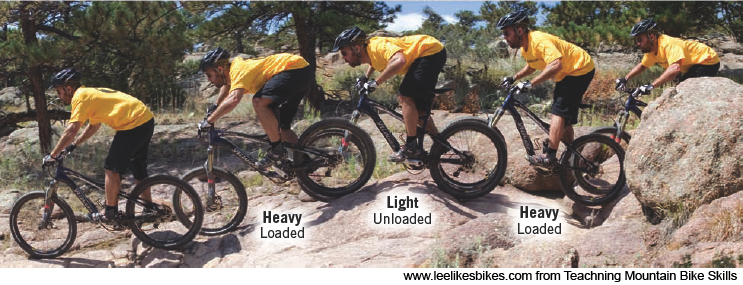Benefits of full suspension if you know how to Ride

Lee,
Question is hardtail vs. FS. Been riding a Gary Fisher 29er Paragon hard tail for 5 or 6 yrs. Have thought about trading up for a full suspension bike but started thinking about your riding style advice (have a couple of your books and looks at your website) and realize that usually one is out of the saddle when in technical terrain. I definately hover and have tried to use your attack position for all challenges. Sooo.. how active would a full suspension be and how would it benefit my riding?? thanks, jake
Hey Jake,
Thanks for writing.
Most riders use full suspension as protection against stiff, out-of-phase riding. On a modern suspension bike you can ride very poorly and still get away with it. That’s what most FS bikes are used for: poor riding.
In my mind, good Riding (capital R) has these traits:
• Delicate balance
• Expansive range of motion
• Big angles
• Aggressive pump, aka riding the trail like a sine wave
 Pumping a rock section on a 2007 Specialized Enduro. Full suspension allows much more aggression (at least at my level and with my bad shoulders) than a hardtail. |
 Riding a big sine wave. A turbo ripper could do this on a hardtail. Six inches of suspension helps me reengage with the ground and redirect more smoothly. |
Very few people — even top XC and Xterra pros — ride this way. Heck, I’ve worked some some elites this year that have been kicking butt despite some pretty bad riding habits.
If you know how to Ride, rear suspension delivers these potential benefits:
More traction. Whether you’re braking, cornering or pedaling (or pumping!), your rear wheel is more likely to stick and less likely to skip. This is generally safer and faster.
Easier speed. Because your suspension is absorbing the myriad small hits, less force gets transmitted to you, and you roll more easily over bumps. Especially the little bumps that you can’t (and shouldn’t) handle consciously.
Increases the size of threshold obstacles. The bigger your wheels and the more suspension you have, the bigger bumps you can ignore. On an XC hardtail I might skim over rocks a few inches tall. On a DH bike, that threshold might be doubled or more. The bigger the stuff you can ignore, the farther ahead you can look and the bigger the wave you can ride.
Bigger sine wave. To me this is the ultimate awesomeness of suspension. More suspension lengthens your bike’s wavelength the way softening a diving board slows its bounce. The longer your wavelength, the longer your light and heavy moments. This means you can bound through rocks and rally corners at a whole new level.
Protection against poor riding. Hey, the best of us get tired and blow sections. Suspension takes the edge off those impacts and makes it easier to stay balanced when you’re not Riding perfectly.
I rode a Santa Cruz Tallboy last weekend in Austin, TX. The rear suspension felt good while I was Ripping It, and it carried me through some mistakes too.
Braaap!
Lee
Know more. Have more fun!
Join the leelikesbikes mailing list:

Leave a Reply
Want to join the discussion?Feel free to contribute!